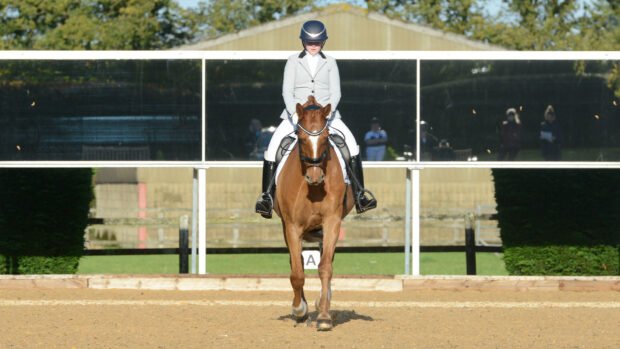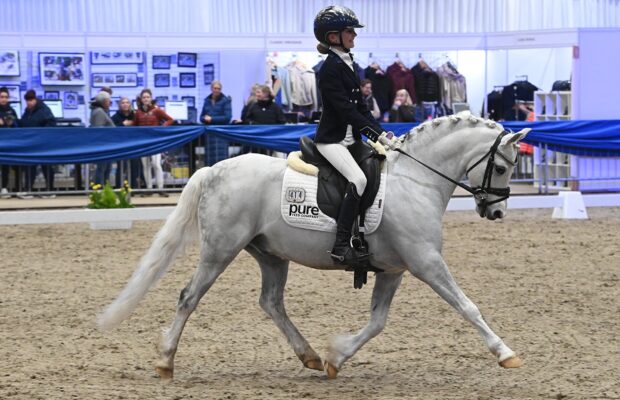Top show producer Aimee Devane (pictured) reveals how she uses shoulder fore to improve flexion and engagement, while maintaining impulsion and power.
Aim
Ensuring that show horses and ponies are able, and willing, to flex and bend correctly is something to perfect before you get in the ring. At home, I spend a lot of time working on suppleness with the natives I have in. Mountain and moorlands can be strong to ride and some breeds have a tendency to lean on the forehand. Therefore, practising exercises like the shoulder fore helps the rider establish greater flexion and control, which is especially useful when you’re on a go-round with more than 40 other ponies in the class.
The exercise: shoulder fore
1. It’s best to introduce the shoulder fore in walk and work towards completing it in working trot, sitting or rising. When you have perfected this then you can work up to canter, but this would take time over a number of sessions.
2. Starting on the right rein, come on to the long side of the arena and turn as if you’re going to ride a 10-metre circle in the corner.
3. As your horse takes that first step on to the circle, half-halt and ride straight down the long side. Your outside (left) rein supports the horse’s outside shoulder. You may need to adjust the contact on this rein to make it firmer. Use the outside leg to stop the quarters swinging out by placing the thigh, knee and lower leg behind the girth. This leg should remain passive and simply act as a support for the horse. The inside (right) rein keeps the angle and controls the amount of bend — do this by gently opening the hand and softly squeezing the contact — while the inside leg needs to be on the girth to actively push the horse forward and sideways. Note that in the shoulder fore position, the horse should move the shoulders in off the track, while the hindquarters remain where they are.
4. Make sure you position your body correctly with your seat weighted slightly to the inside and your inside hip forward. Look between the horse’s ears and keep your shoulders parallel with the horse’s shoulders. You must maintain impulsion, self-carriage and tempo, meaning that the horse should feel more uphill.
Article continues below…
You might also be interested in:

#SundaySchool: Dan Greenwood on improving suppleness (after lockdown lifts)
The grand prix dressage rider discusses using turn on the forehand to improve suppleness and refine the horse’s understanding of

#SundaySchool: Ludwig Svennerstål — the benefits of practising shoulder-in on a circle
Swedish Olympic event rider Ludwig Svennerstål explains how shoulder-in on a circle encourages self-carriage

Subscribe to Horse & Hound magazine today – and enjoy unlimited website access all year round
Tips and pitfalls when riding shoulder fore
- Bear in mind that you don’t have to keep the movement for the entire length of the arena, but aim for a few good steps then come round and try again.
- Try not to have too little or too much bend. Make sure you provide enough outside rein contact and don’t have too much inside rein tension, as this causes too much bend in the neck.
- Don’t make the angle to the inside track too sharp as this then almost becomes a leg-yield. The angle should be about half that of the shoulder-in, so 15°.
- If the hindquarters drift out, your thigh, knee and lower leg are not supporting the horse enough. Check your outside leg is positioned correctly behind the girth and against the side of your horse.
- If the horse is young or green, then this form of exercise will initially take a lot of energy and brainpower so take plenty of walk breaks in between attempts.
We continue to publish Horse & Hound magazine weekly during the coronavirus pandemic, as well as keeping horseandhound.co.uk up to date with all the breaking news, features and more. Click here for info about magazine subscriptions (six issues for £6) and access to our premium H&H Plus content online.




